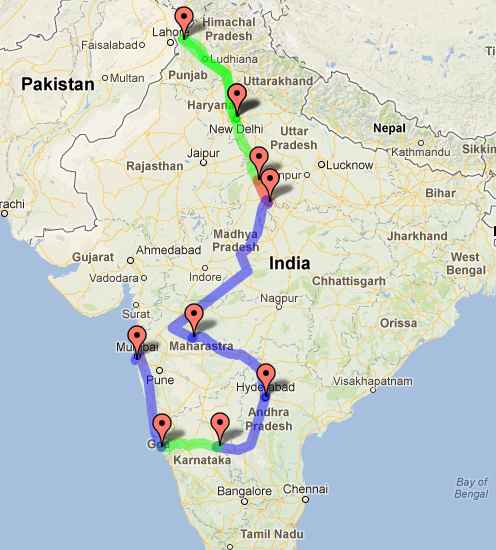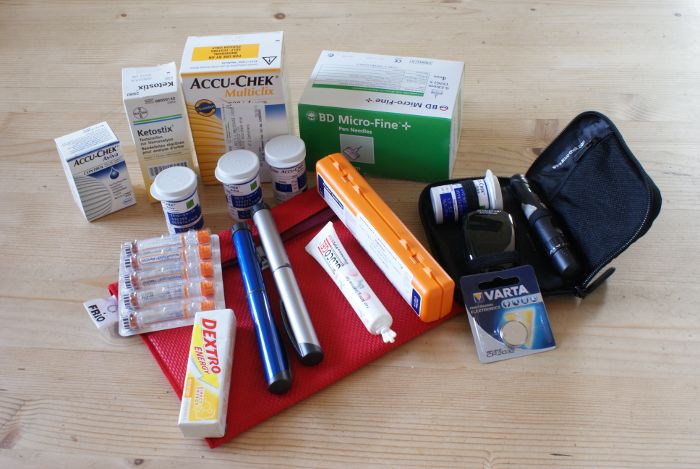In late July 2011, exactly 7 months after Amy was diagnosed with type 1 diabetes, we backpacked around India for four weeks, in a trip we called Monsoon Meandering.
This is post 5 in the series about that trip and its planning and how type 1 diabetes played a part.
The first part of it has been reproduced from the Monsoon Meandering blog article I wrote.
From my original article…
Most of the planning and preparation for this trip has been going really well but we still had one area of concern: the diabetes medical kit. Today we decided to sort that one out so we could relax a little more.
As a little background, after the last trip where we used very, very little of what we actually took we vowed that any medical kit for future trips would be small, very small. For our main medical kit this maxim will still ring true and it’s a good job because we’re taking rather a lot of medical stuff for Amy’s diabetes management.
So here it all is. Well actually it’s not all there, we’re taking double of everything you see in the picture, split across two different bags just in case one gets lost or stolen. This may seem a little over the top but there’s no way I’m risking losing a bag and being in the middle of nowhere for a few days with no Insulin immediately to hand.
Roughly in a top to bottom, left to right list here it all is: Accu-check control solution, Ketostix, Accu-check sterile lancets, Novo-pen 4mm needles, Accu-check testing strips, Novo-rapid insulin spares, Novo-rapid pen including cartridge, Levemir pen including cartridge, Glucogel, Glucagon, Accu-check blood glucose testing kit, Detro tablets, spare battery for Accu-check meter
Each bag’s worth of supplies can be broken down like this
To keep any medical supplies cold
– 1 x extra large Frio wallet
For blood/glucose level checking
– 1 x meter with multi-clix lancing device
– 34 x multiclix units, each containing 6 lancets
– 150 x Accu-check testing strips
– 1 x Accu-check control solution to test the meter if required
For the injections
– 1 x Novo-pen for Novo-rapid insulin, kept in a Frio wallet
– 1 x Novo-pen for Levemir insulin, kept in a Frio wallet
– 100 x Novo-pen 4mm needles
– 2 x spare Novo-rapid insulin cartridges, kept in a Frio wallet
For treating hypos (hypoglycaemic attacks)
– 2 x Dextro Energy packs – these are easily available in India under brand names like Glucoburst
we’ll also have other foods to hand at all times
– 1 x Glucogel, for treatment of a bad hypo*.
– 1 x Glucagon, for treatment of an extremely bad hypo*, to be kept in a Frio wallet
* luckily we’ve not yet had to use any of this
For anything else
– 25 x Ketostix, for testing for Ketosis
Post trip analysis of the kit
What we wouldn’t take next time Nothing! We didn’t need to use the Ketostix, the Glucogel or the Glucagon (thank God!) but you can’t leave these at home.
What would we take more of? Dextro tablets. According to my research prior to the trip dextrose tablets are available in India but we looked in Delhi, Aurangabad and Hyderabad and didn’t find any; we asked at pharmacies and couldn’t find any. We ran out – see next ‘Running out of dextrose tablets’.
The almost serious bag loss
Having packed everything in two bags we felt safe and confident that we’d never be without the necessary supplies, even if we lost a bag. That was until we lost them, BOTH.
At the hotel in Orchha we put all of our rucksacks – bigs ones first – into the autorickshaw. Jane and I climbed in first and rested the diabetes-supply-filled-daysacks on top of the luggage, just behind our heads. The kids got in and the driver drove away slowly as it was raining and the road was full of potholes and bumps.
He got a call on his mobile and unbelievably (for autorickshawwallahs) stopped.
Then two guys pulled up on their motorbikes, shouting at the driver in Hindi, although they didn’t seem angry.
Then we saw the bags, all dirty and wet. The guys had spotted them fall out, which happened as there was no fixed back to the autorickshaw, just a rain cover. The guys wanted no money and wouldn’t take what I offered. That’s what people in India are like, they’re just happy to help (mostly).
Running out of dextrose tablets
In the first couple of weeks Amy had quite a few hypos, caused because she was injecting before she ate and then deciding she didn’t like it so much. At this point we weren’t carb counting and she was taking a regular amount depending on the size of the meal. After a week or so we realised what was happening and started doing the injections afterwards.
We were running out of Dextrose tablets and we looked everywhere we could to find some, when we weren’t sightseeing. It didn’t seem like a big thing as we were going to the bigger cities of Aurangabad and Hyderabad and would surely find supplies there. We didn’t.
In Hyderabad I started getting nervous as we were soon boarding a train to Hampi (station:Hospet) and that place is really out in the middle of nowhere. I didn’t have much hope of finding any in Hampi.
We went to a pharmacy and then another and they could offer us was powder, the type used by bodybuilders, in huge containers. We didn’t buy anything.
It’s worth pointing out that in India there’s so many possible alternatives, so many things are sweets. A good example is Barfi, a sweet mostly made from milk…and sugar. It contains on average 17g of carbohydrate per piece, keeps for ages and is available absolutely everywhere.
At the time though we fixated on the need for dextrose tablets, rather than the bigger picture of needing emergency simple carbs.
I emailed our DSN in Royal Hampshire County Hospital in Winchester and got back a reply almost instantly saying “don’t panic, just get hold of some sugar cubes at a cafe or shop and use 2 cubes for any hypo” (followed by some more complex carbs of course). It was so nice to have someone tell us what to do and break our fixation.
We ran totally out of dextrose at our hotel in Hospet and explained to the waiter who just said “take these cubes, all of them”. We had enough cubes for several hypos and every now and then we did same thing and got a stash of more cubes.
We never did find any dextrose tablets.
UPDATE: My friend Gretchen, an insulin dependent diabetic, is currently on her travels and has found it impossible to find dextrose/glucose tablets too.
Next up – cooling insulin with Frio wallets




